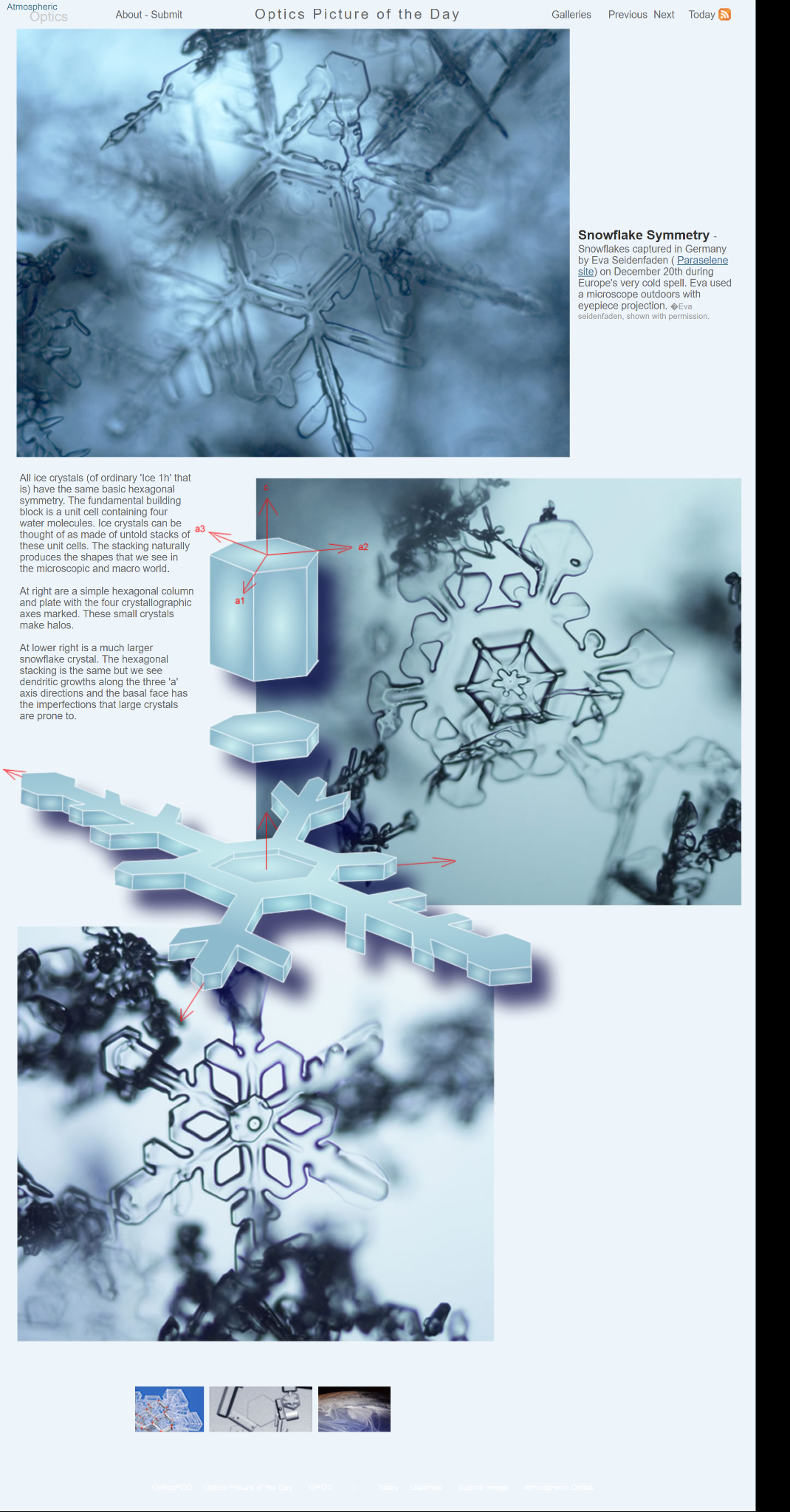Snowflake Symmetry
Snowflake Symmetry: A Closer Look at Nature's Masterpiece
When it comes to the intricate beauty of snowflakes, one cannot help but marvel at their mesmerizing symmetry. Each snowflake, with its delicate and unique structure, is a testament to the elegance of nature's design. While we may see them as small and delicate, snowflakes are actually composed of countless ice crystals, all exhibiting the same hexagonal symmetry.
The Building Blocks of Snowflakes
At the core of every snowflake lies a fundamental unit cell, housing four water molecules. These unit cells stack upon one another, creating the mesmerizing structures that captivate our eyes. From the microscopic to the macro world, this stacking process naturally gives rise to the diverse shapes and patterns we observe in snowflakes.
Exploring Crystallographic Axes
To better understand the symmetrical nature of snowflakes, let's examine two distinct examples. The first is a simple hexagonal column and plate, both displaying the four crystallographic axes. These smaller crystals are responsible for producing halos, adding a touch of magic to snowy landscapes.
On the other hand, the second example showcases a much larger snowflake crystal. While the hexagonal stacking remains consistent, this crystal exhibits dendritic growths along the three 'a' axis directions. Additionally, due to its size, the basal face may display imperfections that larger crystals are prone to developing.
The Wonders of Snowflake Formation
Snowflakes are born in the frigid depths of clouds, where tiny ice crystals form around microscopic particles known as ice nuclei. As these crystals grow, they branch out into intricate patterns, shaped by temperature and humidity variations within the cloud. This process results in the formation of unique and symmetrical snowflakes.
Embracing Nature's Variations
While we often associate snowflakes with perfect symmetry, the reality is that no two snowflakes are exactly alike. As they journey through the atmosphere, snowflakes encounter different environmental conditions, causing variations in their growth patterns. These variations give each snowflake its own individuality, making them truly one-of-a-kind.
The Art of Snowflake Photography
Capturing the delicate beauty of snowflakes requires a skilled hand and a keen eye. Photographers like Eva Seidenfaden have mastered the art of snowflake photography, using specialized techniques to bring these intricate structures to life. By utilizing microscopes with eyepiece projection, Seidenfaden captures the enchanting details of snowflakes, revealing their symmetrical splendor for all to admire.
Beyond Snowflakes: Atmospheric Optics
Snowflake symmetry is just one example of the captivating phenomena that fall under the realm of atmospheric optics. From rainbows and halos to sundogs and mirages, our atmosphere is filled with breathtaking optical displays. These natural wonders occur due to the interaction of light with atmospheric particles, ice crystals, and water droplets, resulting in a stunning visual spectacle.
Unlocking the Mysteries of Symmetry
Scientists and researchers continue to delve into the mysteries of snowflake symmetry, seeking to unravel the underlying mechanisms that govern their formation. Through advanced imaging techniques and mathematical modeling, they strive to understand how environmental factors shape the intricate patterns we see in snowflakes. By uncovering these secrets, we gain a deeper appreciation for the wonders of nature's craftsmanship.
Embracing the Magic of Snowflakes
Next time you find yourself caught in a snowfall, take a moment to observe the delicate snowflakes that grace the world around you. Each one is a testament to nature's ability to create breathtaking beauty through symmetry. From their humble beginnings as tiny ice crystals to their intricate and unique structures, snowflakes remind us of the awe-inspiring wonders that exist within our natural world. So, embrace the magic of snowflakes and let their symmetrical splendor captivate your imagination.

Snowflake Symmetry - Snowflakes captured in Germany by Eva Seidenfaden ( Paraselene site) on December 20th during Europe's very cold spell. Eva used a microscope outdoors with eyepiece projection. �Eva seidenfaden, shown with permission.
All ice crystals (of ordinary 'Ice 1h' that is) have the same basic hexagonal symmetry. The fundamental building block is a unit cell containing four water molecules. Ice crystals can be thought of as made of untold stacks of these unit cells. The stacking naturally produces the shapes that we see in the microscopic and macro world.
At right are a simple hexagonal column and plate with the four crystallographic axes marked. These small crystals make halos.
At lower right is a much larger snowflake crystal. The hexagonal stacking is the same but we see dendritic growths along the three 'a' axis directions and the basal face has the imperfections that large crystals are prone to.

Note: this article has been automatically converted from the old site and may not appear as intended. You can find the original article here.
Reference Atmospheric Optics
If you use any of the definitions, information, or data presented on Atmospheric Optics, please copy the link or reference below to properly credit us as the reference source. Thank you!
-
<a href="https://atoptics.co.uk/blog/snowflake-symmetry/">Snowflake Symmetry</a>
-
"Snowflake Symmetry". Atmospheric Optics. Accessed on December 26, 2024. https://atoptics.co.uk/blog/snowflake-symmetry/.
-
"Snowflake Symmetry". Atmospheric Optics, https://atoptics.co.uk/blog/snowflake-symmetry/. Accessed 26 December, 2024
-
Snowflake Symmetry. Atmospheric Optics. Retrieved from https://atoptics.co.uk/blog/snowflake-symmetry/.